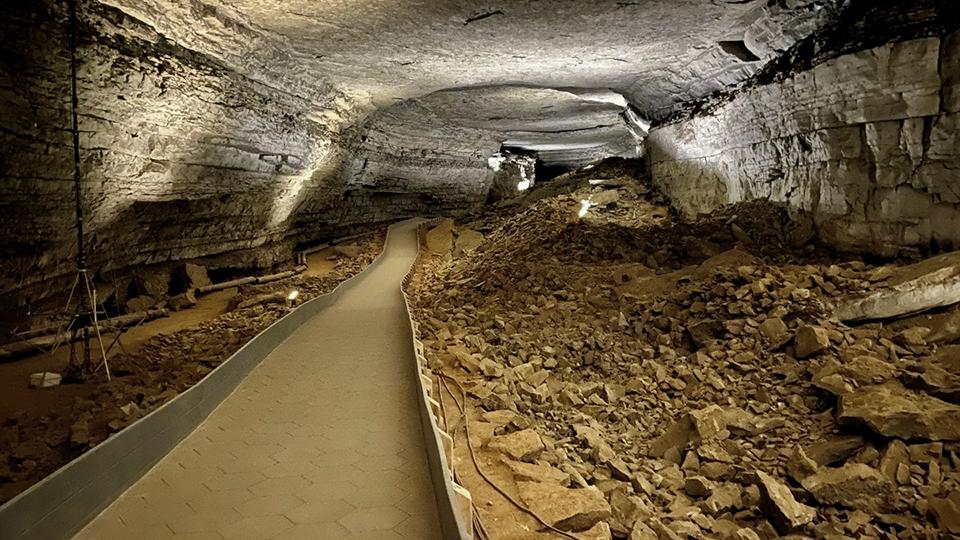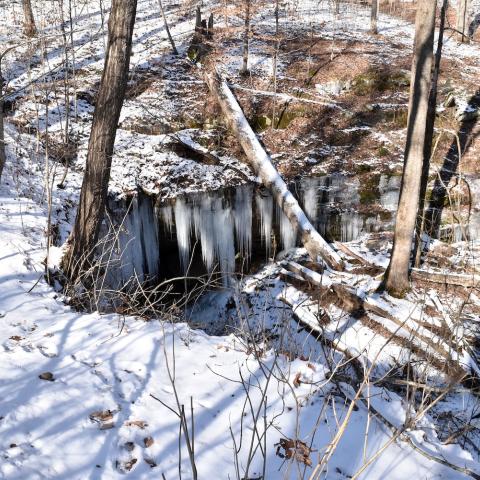
The historic entrance to Mammoth Cave, Mammoth Cave National Park / National Park Service
In addition to celebrating Independence Day, we should also celebrate the July establishment of Mammoth Cave National Park in Kentucky, and light a birthday candle for Stephen T. Mather, whose “vigorous efforts to build public and political support for the parks helped persuade Congress to create the National Park Service in 1916.” Let’s see just how much you know about these July notables. Test your knowledge before viewing the answers at the bottom of this piece.

Stephen T. Mather in Sequoia National Park / National Park Service
1. True or False: Stephen Mather was appointed the first National Park Service Director in 1916.
a) True
b) False
2. Stephen Mather became a millionaire through his marketing efforts working for:
a) Thorkildsen-Mather Borax Company
b) Olgivy & Mather Public Relations Agency
c) Mather Lifeways
d) Mather Family Enterprises
3. Geologists estimate the oldest part of Mammoth Cave began forming around _____ years ago.
a) five million
b) 10 million
c) 15 million
d) 20 million
4. True or False: Mammoth Cave is the longest known cave system in the world.
a) True
b) False
5. True or False: Mammoth Cave got its name from the mummified mammoth found within the cave depths.
a) True
b) False
6. The type of landscape where the dissolving of the bedrock has created sinkholes, sinking streams, caves, springs, and other characteristic features is known as:
a) metamorphic
b) karst
c) acidizing
d) speleothem
7. “A depression or hole formed when the land surface sinks due to underground bedrock dissolution or cave collapse” is known as a ____.
a) sinking stream
b) cenote
c) waterhole
d) sinkhole
8. True of False: Stalactites rise up from the ground due to calcium carbonate-laden dripping water falling in the same place.
a) True
b) False

Cave debris along Broadway Trail, Mammoth Cave National Park / NPS-Jackie Wheet
9. As you wander through Mammoth Cave, you’ll come across heaps of debris all along the cave floor. This debris is known as ___.
a) cave fill
b) speleothem
c) breakdown
d) anthodite

Marine invertebrate bedrock fossils, Mammoth Cave National Park / National Park Service
10. Mammoth Cave National Park preserves fossils from two different time periods in Earth's past, separated by millions of years. We can organize them into two categories: Paleozoic bedrock fossils, and ____.
a) Cenozoic cave fossils
b) Cambrian cave fossils
c) Proterozoic cave fossils
d) Pliocene cave fossils
Trivia
“Among Stephen Mather’s first actions as head of the NPS was to persuade three accomplished naturalists to investigate the state of the redwood forests in northern California. Through his influence, Madison Grant of the New York Zoological Society, John C. Merriam of the University of California, Berkeley, and Henry Fairfield Osborn of the American Museum of Natural History, embarked on an historic expedition to the redwoods. Their experience there in 1917 laid the foundation for Save the Redwoods League, which was created the next year in large part through funds raised by Mather. Throughout the rest of his life, Mather used his personal and political relationships to mold the organization into a successful partner of private and public institutions.”
“In 1981, at the fifth session of the World Heritage Committee in Sydney, Australia, Mammoth Cave National Park was inscribed as a World Heritage Site. This international designation is governed by the World Heritage Convention of the United Nations Educational, Scientific, and Cultural Organization (UNESCO). The UNESCO World Heritage Convention recognizes Mammoth Cave as the most extensive cave system in the world and for its unique examples of cave and karst landscape geology. Nearly every type of cave formation is known within the site and Mammoth Cave is the richest cave-dwelling wildlife known, with more than 130 species within the cave system.”

Flowstone at Frozen Niagara, Mammoth Cave National Park / National Park Service
Mammoth Cave is filled with more than stalactites and stalagmites. Examples of other cave formations you’ll see during a visit there are:
- Flowstone: sheets of calcium carbonate that form along cave walls. Flowstone hangs downward and may create curtain-like sheaves along ledges, better known as draperies. The most notable flowstone formation in Mammoth Cave is the Frozen Niagara.
- Helictites: shapes that form in cave areas with minimal water seepage. Because water does not drip off of the helictite, as would happen with a stalactite, the water coats its surface creating strange, branch-like shapes. Helictites can be seen along the Great Onyx Lantern Tour.
- Cave Popcorn: knobs of calcite that form where water seeps through pores in limestone, creating clusters that resemble popcorn, peas, or grapes. Cave Popcorn can be seen along the Grand Avenue and Domes and Dripstone Tour.
To learn more about cave minerals and formations, click here.
Quiz Answers
1b False
Stephen T. Mather was appointed the first NPS director in May 1917. “During his tenure, the service’s domain expanded eastward with the addition of Shenandoah, Great Smoky Mountains, and Mammoth Cave national parks. Periodically disabled by manic-depression, Mather left office in January 1929 after suffering a stroke and died a year later.”
2a
“Mather was a successful industrialist who started his career as a reporter with the New York Sun and after five years joined the Pacific Coast Borax Company in New York where his father worked. In 1894 he and his wife, Jane Floy Mather moved to Chicago with Borax. He is credited with coining the slogan "20 Mule Team Borax" which branded the commodity and made Borax a household name. In 1903 he created the Thorkildsen-Mather Borax Company with a friend and by 1914 was a millionaire, giving him the flexibility to retire and pursue other interests.”
3b
Geologists estimate that the oldest part of Mammoth Cave began forming around 10 million years ago. Click here to learn more about Mammoth Cave’s age, how it formed, and the different types of cave passages that exist within the system.
4a True
“To date, explorers have mapped and surveyed more than 412 miles of cave passage, making Mammoth Cave by far the longest known cave system in the world. The explorers are still discovering new passages, and they often say that ‘there is no end in sight.’"
5b False
“The name ‘Mammoth’ was first used to describe the cave in the early 1800s. It refers to the ‘mammoth’ size of the cave's chambers and avenues, not the prehistoric elephant-like mammal.”
6b
“Karst [landscape] is associated with soluble rock types such as limestone, marble, and gypsum. In general, a typical karst landscape forms when much of the water falling on the surface interacts with and enters the subsurface through cracks, fractures, and holes that have been dissolved into the bedrock. After traveling underground, sometimes for long distances, this water is then discharged from springs, many of which are cave entrances.”
7b or d
Ok, this is a bit of a trick question. A cenote is “a natural pit, or sinkhole, resulting from the collapse of limestone bedrock that exposes groundwater. The regional term is specifically associated with the Yucatán Peninsula of Mexico.” In North America, however, the answer is “sinkhole.” So, with some wiggle room, either choice is correct.
8b False
Stalactites form along ceilings and hang downward. Here’s a couple of ways to remember the difference between stalactites and stalagmites: StalaCtite (“c” for coming from the ceiling) versus stalaGmite (“g” for coming up from the ground), and StalacTITE (hanging “tight” onto the ceiling) versus stalagMITE (pushing up from the ground with all its “might”).
9c
“Rock material produced by the collapse of the ceiling or walls of a cave is called breakdown and may range in size from plates and chips to massive blocks. Most breakdown present in caves today appears to have occurred thousands of years ago. It is generally associated with the early history of cave development.”
10a
In addition to Paleozoic bedrock fossils, the other time period category for Mammoth Cave fossils is the Cenozoic cave fossils category. To read more about these categories and the fossils found, click here.
References
In addition to information found on the NPS websites for these parks and for Stephen T. Mather, I also used the following as references:
Note: Different websites may have different national park establishment dates, so, I used this NPS publication as the standard.
https://www.nps.gov/parkhistory/online_books/sontag/mather.htm
https://www.matherhomestead.org/stephen-mather
https://www.savetheredwoods.org/about-us/mission-history/stephen-t-mathe...




 Support Essential Coverage of Essential Places
Support Essential Coverage of Essential Places







Comments
This was fun and very interesting.